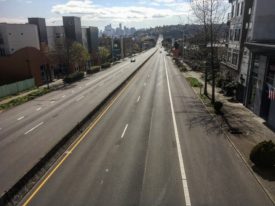 The U.S. poverty line is a notoriously bad measure of economic hardship. First, it’s stingy: in 2003 a family of four could earn as little as $18,401 and still not be considered impoverished. Obviously, many families who are well above the poverty line still find it impossible to make ends meet. Second, it’s inflexible: the poverty line is the same in Spokane as it is in Manhattan, even though the cost of living differs considerably between the two places.
The U.S. poverty line is a notoriously bad measure of economic hardship. First, it’s stingy: in 2003 a family of four could earn as little as $18,401 and still not be considered impoverished. Obviously, many families who are well above the poverty line still find it impossible to make ends meet. Second, it’s inflexible: the poverty line is the same in Spokane as it is in Manhattan, even though the cost of living differs considerably between the two places.
Part of the problem with the federal poverty line is that it is badly out of date. Many people think that the poverty line represents the cost of a minimal basket of goods and services that is recalculated each year as prices rise. That’s not so. In reality, the poverty line was originally based on the cost of an “economy food plan” circa 1965—a food budget that the Agriculture department said was “designed for temporary or emergency use when funds are low.” In 1955 the average family spent about a third of their after-tax income on food; for lack of solid data it was assumed that poor families did the same, so the poverty line was set at three times the cost of the emergency food plan.
Since that time, the poverty line has been adjusted upwards for inflation each year. But inflation is a tricky business: the cost of food and clothing has gone up slower than average, while the cost of housing and medical care has gone up much faster. For the very poor, the declines in food prices may have been more than offset by increases in housing expenses. The result, after nearly 40 years of such changes, is that the poverty line doesn’t mean much anymore—it’s just a number, and an increasingly deceptive one.
Even the architect of the poverty line thought that it was flawed: she believed it would yield a “conservative underestimate” of the number of people actually in poverty. But there’s even less reason today than there was 40 years ago to believe that the poverty line really represents the level at which financial hardship begins. Many government low-income assistance programs (such as food stamps and subsidized school lunches) recognize this fact, by setting eligibility cutoffs well above the federal poverty guidelines.
A few years ago, researchers from the Economic Policy Institute tried to figure out a better way of calculating the level of income needed to avoid financial hardship. They collected data on actual costs of necessities—food, clothing, housing, transportation, child care, taxes and the like—for a number of cities and rural areas across the country. And what they found, not surprisingly, was that families well above the poverty line could still face significant financial hardship.
For Seattle, a family with two adults and two children needed to earn about $39,775 to make ends meet in 1999. That was well over twice the official poverty line. Here’s the hardship level for all Northwest areas they looked at:
| City/Place | Family Budget |
|---|---|
| Pocatello, ID | $32,121 |
| Rural ID | $33,801 |
| Boise City, ID | $34,645 |
| Salem, OR | $34,719 |
| Rural OR | $34,862 |
| Spokane, WA | $34,878 |
| Eugene-Springfield, OR | $35,372 |
| Yakima, WA | $35,573 |
| Rural WA | $35,925 |
| Medford-Ashland, OR | $36,313 |
| Tacoma, WA | $36,519 |
| Bremerton, WA | $37,138 |
| Portland-Vancouver (Ore. portion) | $37,306 |
| Portland-Vancouver (Wash. portion) | $37,646 |
| Olympia, WA | $37,851 |
| Richland-Kennewick-Pasco, WA | $38,256 |
| Bellingham, WA | $38,398 |
| Seattle-Bellevue-Everett, WA | $39,775 |
One of the side benefits of EPI’s research is that it sheds more light on the cost of living in different parts of the U.S. Judging by the “financial hardship” level, Seattle’s cost of living was the highest in the Northwest: for a family of four, it cost $7,600 more per year to live in Seattle than in Pocatello, Idaho. That accords with most people’s intuitions—and suggests that the official poverty rate in Washington (11% in 2002) represents a greater amount of hardship than the slightly higher rate in Idaho (11.3%).
As with all statistics, the real trick to understanding data on federal poverty rates is to learn from them what you can, but not to be beguiled by them. They mean less than you might think.







